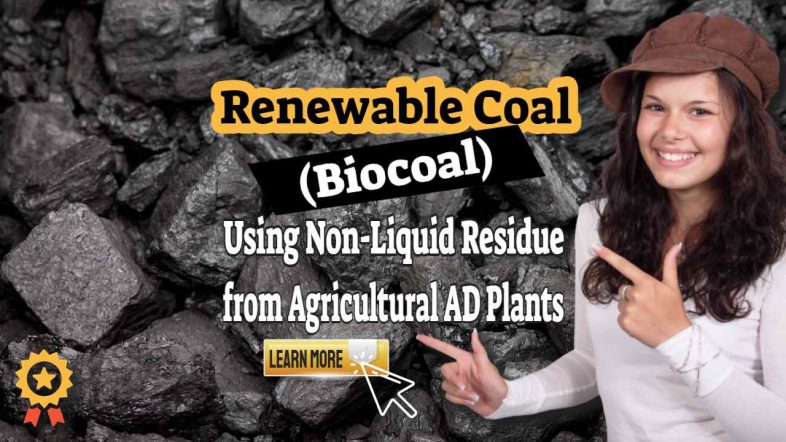A process for the formation of “Renewable Coal” or “biocoal” (Renewable Natural Coal from the Waste Output of a Cattle/Agricultural based Biogas Plant) has been patented following research by Ankit Patil. Ankit is an entrepreneurial young scientist and former student of Vincent Palloti College of Engineering. He has a masters degree from St Petersburg Polytechnic University, Russia in power plant engineering with skills to bring new products to the market.
Anaerobic digestion bio-reactors produce biogas (essentially a mixture of methane with some carbon dioxide and other gases at low “trace” levels) and a slurry (digestate).
Until recently, this output was considered to be a waste and at worst can be costly to dispose of. When produced by agricultural AD plants it is often used for land spreading where it has benefits as a fertiliser and soil structure improver.
However, the amount that can be spread is limited by the need to ensure that ammonia levels in the soil do not exceed permissible levels. And metal accumulation in the soil is also a problem for the fibrous digestate from most sewage sludge biogas plants and municipal solid-waste derived biowaste.
Some form of thermal treatment or pasteurisation is usually also needed to sterilize the output and avoid spreading disease vectors that may be present in the biowaste on arrival at the biogas facility.
For a long while, scientists and biogas industry professionals have been seeking ways to make use of the biogas plant output, so this news is very welcome.

Renewable Natural Coal from Agricultural Biogas (AD) Plant Digestate Fibre
The Australian patent for this new technology relates to a method of producing renewable natural coal, which can have uses such as:
- bio-coal as a fuel for cooking and heating
- a cattle bedding or
- as torrefied biomass for use to create organic chemicals in the renewable refineries of the future.
The types of biomass which can be used, apart from the dried fibre (solid) waste from a biogas plant according to Ankit are:
- dry manure,
- other dry biomass.
However, it is the use of waste obtained from the output of a biogas plant that is most innovative. At its most basic, the invention relates to producing renewable coal from biomass by thermochemical treatment.
How Biogas Coal (Biocoal) is Different from Geological Non-renewable Coal
Coal is formed when dead plant matter decays into peat and is converted into coal by the heat and pressure of deep burial over millions of years.
A parallel to that geological principle can be utilized for the solid output from, for example, a cattle waste (manure, dung or “gobar”) biogas plant. The cattle waste decomposes and forms biogas. Subsequently, after a period during which it is retained in the digester whatever remains that the microorganisms have not consumed is discharged from an outlet which is called the digestate or “output slurry”.
The gross calorific value of the obtained renewable natural coal when tested fell in the range of 2,989 Kcal/kg to 3439.94 Kcal/kg. By comparison, house-fire coal has a calorific value of 6,500 – 8,000 kcal/kg, so the heat outputs less than half of most house coals.
Benefits of Biogas Coal versus Non-renewable Coal

Once processed in the patented method a material remains (called “renewable natural coal” in the patent) which when burnt as a fuel helps to reduce consumption of natural coal.
It is also assumed that this renewable coal will be in demand throughout the period up to and beyond “Net Zero” in 2050, and command a good price when sold. However, the details revealed provide only a few details of the important aspects which this form of renewable coal (bio-coal) will need to offer.
Needed before it becomes a marketable product for burning on open fires and in domestic coal boilers such as:
- high caloric value similar to fossil/ geological/ mineral coal or be offered at a much lower price than mineral coal
- low smoke or smokeless burning characteristics
- low air emissions (low air polluting NOx etc).
Other benefits attributed by Ankit are that it will:
- help to restart biogas plants after shut-downs
- generate revenue and
- raise employment available in rural areas.
Summarising the Invention of Renewable Biogas Coal
The present patent disclosure describes a system and a process for the formation of renewable natural coal from waste output cattle and other agricultural-based biogas plants.
In this new process “natural coal” is formed from what is left over after biogas has been produced by dead plant matter which decays without oxygen in a biogas reactor. The solid biowaste which can't be digested into methane is, we assume, converted into usable coal-like blocks. However, no detail is available at this stage.
Accordingly, via this patent, biogas plant output is made into a usable biofuel, most commonly known as a bio-coal. The output slurry obtained from the biogas plant ceases to be a burden and becomes valuable.
The output slurry from the biogas plant has always been a good fertilizer and is useful for farming purposes, but until now, only within a limited timeframe.
The gross calorific value of the obtained renewable natural coal falls in the range of just below half that of mineral coals. But, if it lights easily, burns steadily, and is clean burning/ low or smoke-free the heat can be useful for cooking stoves and home fires.
Bio-coal And Using Biogas Where It Is Most Valuable
Historically, open-air dried cattle dung has been used as a cooking fuel in India and other nations with low rainfall and hot climates. There is increasing emphasis on using biogas upgraded to pure biomethane for use to fuel transport vehicles.
This is a purpose for which it is ideally suited. In this fuel requirement, there are few if any economical alternatives to biogas used in fuel transport as biomethane. Biomethane is seeing high demand growth, especially for heavy goods vehicle use.
So, there could be a really important role for renewable coal/ bio-coal in many decarbonized communities in the decades to come where both biogas and the bio-coal output is sold for income. Bio coal might be seen as a much-improved version of dung as fuel. The same might apply to peat, which was once extensively burnt in homes in countries such as Ireland.
“could drive forward the biogas industry like never before.”
If at the same time the liquid output was also sold, this time for use as a crop fertiliser, biogas plants would become far more profitable. Quickly they would become assets with a very attractively low ROI (Return On Investment) period. This could drive forward the biogas industry like never before.





